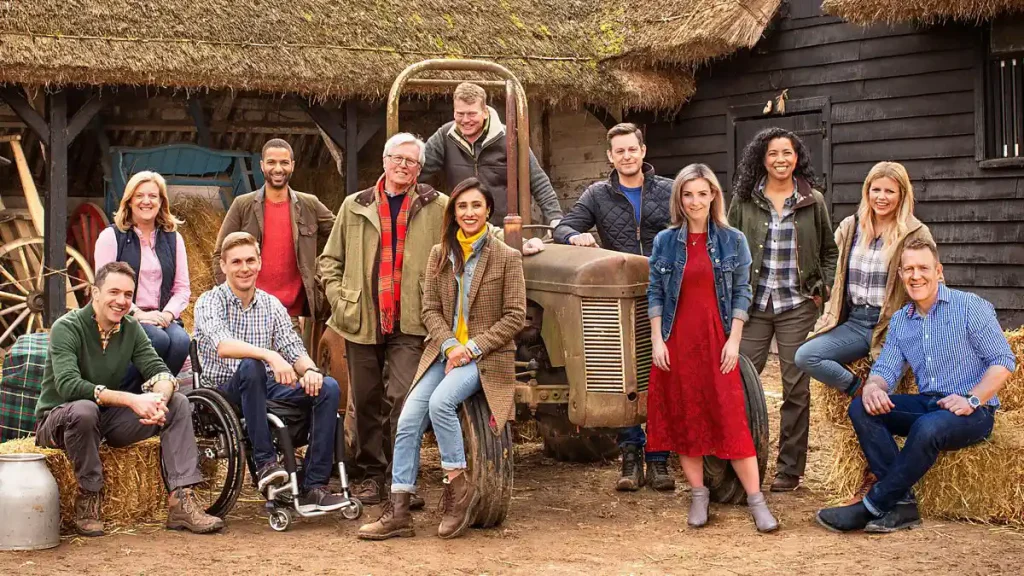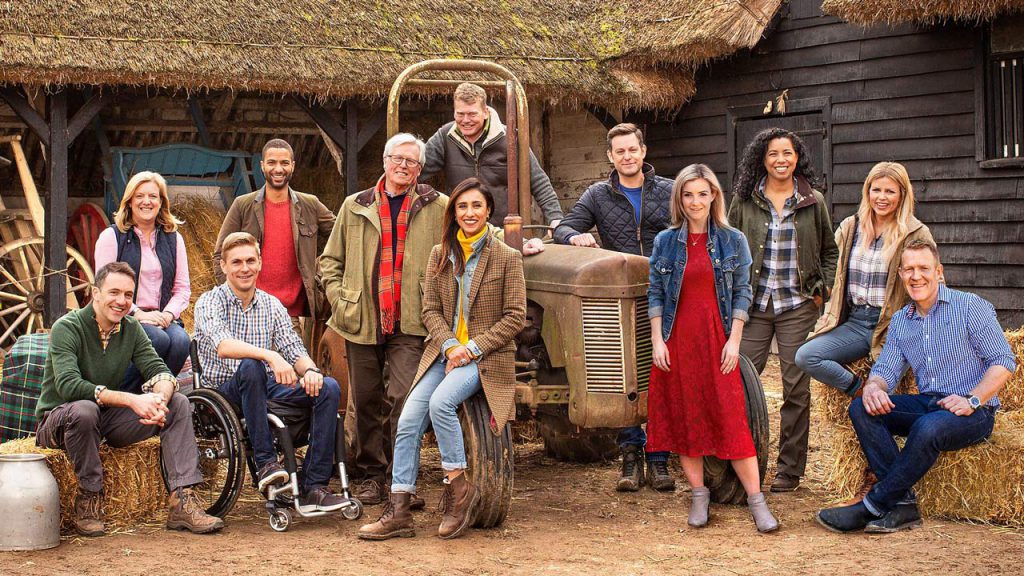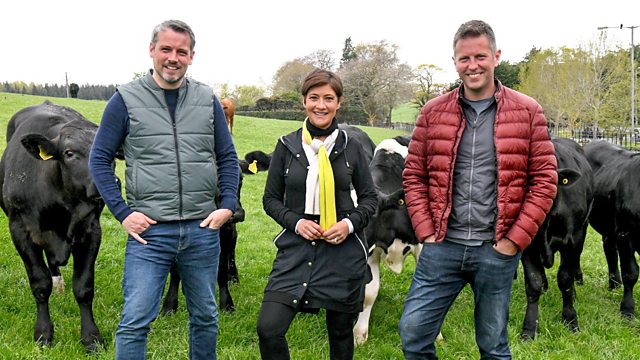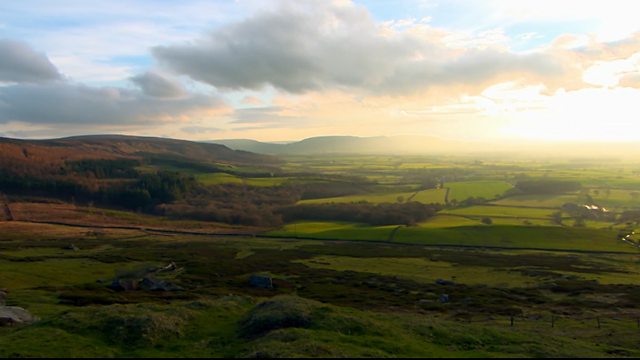Countryfile – Harvest 2 – Presenters Adam Henson and Sean Fletcher make their much-anticipated return to the fertile plains of East Anglia, known as the ‘breadbasket’ of the region, where a staggering one-third of Britain’s entire food supply is cultivated and harvested. On their last visit, viewers witnessed Adam’s exciting encounter with arable farmer Tom Martin during the initial wheat harvest of the season. The anticipation builds as the grain testing results have finally arrived, and Tom eagerly discovers the outcome of this year’s harvest.
As the episode unfolds, journey with Adam as he embarks on a tour of the impressive megastructures purposefully built to house enormous quantities of wheat. Delve deeper into the innovative technology implemented to fiercely guard these high-value crops against the destructive forces of pests and moisture. Learn about the intricate systems in place to ensure the harvested wheat remains in pristine condition.
Parallelly, join Sean as he immerses himself in the captivating world of blueberry harvesting. Accompany him as he partners with farmer Zoe Mee on her sprawling family farm to gain insight into the unique challenges faced while cultivating these beloved berries in the UK’s diverse climate. With a staggering 170 tonnes of fruit harvested each season, witness the marvel of their advanced sorting machine in action. This state-of-the-art equipment, equipped with multiple high-resolution cameras, meticulously grades and sorts each blueberry ensuring only the finest quality reaches consumers across various supermarkets.
Follow Charlotte Smith’s eye-opening investigation into the alarming escalation in rural crime. Discover the pioneering high-tech solutions being deployed to safeguard the farmers’ invaluable assets, ensuring the continuity and sustainability of food production in the region. Revisit Tom Martin’s expansive farm for the thrilling culmination of the harvest season. Share in the joy and relief as Adam and the dedicated farmworkers raise their glasses in a heartfelt toast, celebrating their collective hard work, unwavering commitment, and the bountiful produce yielded.
Lastly, don’t miss the exciting revelation by John Craven as he proudly announces the deserving winner of the esteemed Countryfile photography competition. Admire the stunning image that will beautifully adorn the front cover of the much sought-after 2024 Countryfile Calendar, capturing the essence and beauty of the countryside. Join us for this enlightening and uplifting episode, as we traverse the breathtaking landscapes of East Anglia, exploring the robust and resilient world of agriculture, and celebrating the individuals whose tireless efforts bring bounteous harvests to tables across Britain.
Countryfile – Harvest 2
Presenters Adam Henson and Sean Fletcher are back in the ‘breadbasket’ of East Anglia, where over a third of Britain’s food is produced. Last time, Adam met arable farmer Tom Martin as he harvested his very first wheat crop of the year. Now, the grain testing results are in, and Tom finally learns if this year’s harvest has been a success.
Testing the Wheat
On Tom Martin’s farm in rural Suffolk, the combine harvesters have finished reaping the wheat fields. The golden grain fills the farm’s cavernous metal storage bins, awaiting testing and sale. For Tom, an arable farmer carrying on his family’s generations-old business, the wheat harvest is a make-or-break moment each year. “The quality results from the grain testing laboratory have arrived,” Tom tells Adam Henson, holding the sealed envelope nervously. Adam joins Tom in his farm office, where they carefully open the results together.
Scanning the charts and lab reports, Tom’s apprehension melts into a broad smile. This year’s wheat has achieved the high protein levels needed for bread flour, and low moisture content to avoid spoilage during storage. “It’s a great crop, ticking all the boxes for milling quality,” Tom exclaims. For an arable farmer, a prime wheat harvest means prestige as well as profit. Tom’s wheat will go to make flour for loaves, cakes, and biscuits across Britain. The farm has a reputation to uphold, supplying wheat sought after by major millers and bakers.
Adam can relate to Tom’s evident pride. “As a farmer myself, I know how nerve-wracking those test results can be. All your hopes for the year ride on the quality achieved in those grains,” he says. Having accompanied Tom through the growing season, Adam has seen the backbreaking work and worry invested in coaxing the land to yield superlative wheat. From proper soil nutrition to pest control and harvesting at just the right moment, the challenges are endless. But now, with the favorable lab results, the stress gives way to satisfaction for Tom Martin. This year’s wheat met the grade.
Wheat Storage Solutions
Leaving Tom Martin’s farm, Adam travels a short distance to a cluster of enormous sheds near the fields. He meets Nigel Payne, manager of a large-scale grain storage facility that takes deliveries from farms like Tom’s after harvest. “This is awesome,” Adam says, gazing up at the soaring corrugated metal walls of the wheat silos. Conveyor belts carry a nonstop torrent of grain into the sheds. Inside, the golden wheat fills cavernous bins four stories tall. Nigel explains that their facilities can hold over 90,000 tonnes of grain.
Careful control of temperature, moisture, and pests is vital to keeping the wheat in prime condition, Nigel emphasizes. State-of-the-art systems monitor the storage units, while grain inspectors check samples regularly. “It’s a science keeping the wheat safe and saleable,” he tells Adam. Too much dampness fuels mold and fungi, rapidly ruining the crop. Oxygen enables combustion, and vermin multiply rapidly. The facility must walk a fine line between humidity, sealed containment, and aeration.
Adam examines the technology managing the vast grain stores, essential for supplying flour year-round. From a computerized control room, Nigel tracks readings and oversees the automated systems. The wheat remains here after harvest, then gradually ships out to major milling companies over the following months. Thanks to failsafe storage, the harvest meets demand until the next year’s crop arrives.
Blueberry Bounty
In the southwest of England, Sean Fletcher arrives at Little Court Farm in Devon to meet blueberry farmer Zoe Mee. Zoe’s family converted to growing blueberries 25 years ago and now cultivate 30 acres of berry bushes. “It’s nonstop once picking starts,” Zoe tells Sean amidst the rows of laden bushes. An annual harvest yields around 170 tonnes of fruit. The farm supplies major retailers year-round by freezing some berries for off-season distribution.
Sean gets hands-on experience with the harvest, filling pint baskets with plump blueberries. He samples the sweet organic berries fresh off the bush. “These are so juicy and delicious!” Sean exclaims. He’s struck by the patience and devotion growing quality blueberries requires. The plants take years to mature and bear optimal fruit. Picking must happen at precisely the right moment for flavor and shelf life.
At the packing shed, Sean learns how technology assists the harvest. An ingenious sorting machine uses multiple cameras to grade each blueberry by size, color, and shape. “It’s incredibly meticulous,” Sean says, as Zoe demonstrates the separator funneling berries into boxes destined for different supermarkets. The farm’s reputation depends on this precision sorting and packaging to satisfy its retail clients. Watching the process gives Sean a new appreciation for the care behind every punnet of British blueberries.
Crime on the Countryside
Charlotte Smith meets with rural police officer Doug Conway in Herefordshire to investigate a disturbing trend: a rise in agricultural crime. Thieves are targeting farms to steal expensive vehicles, fuel, and equipment. “It’s organized criminal gangs in many cases,” Doug tells Charlotte. Unoccupied barns stocked with diesel, fertilizer, and tools make tempting targets.
Charlotte accompanies Doug patrolling isolated areas that have suffered a spate of thefts. Many farms implement security measures like motion sensor lights and CCTV cameras. But wily criminals find ways around them. Doug shows Charlotte some new high-tech deterrents farmers are using. “Sensor-activated fog cannons fill areas with disorienting smoke to block trespassers,” he explains. Some farms use forensic marking sprays on roofs to later identify stolen goods.
For police, patrolling the expansive countryside stretches resources thin. “We rely on the rural community being our eyes and ears,” says Doug. Charlotte agrees that combating rural crime requires vigilance from farmers and residents along with law enforcement. Crucial farming assets, from livestock to machinery, need protection to keep the agricultural economy healthy.
Celebrating the Harvest
Back at Tom Martin’s Suffolk farm, the final wheat stores fill with the satisfying fruits of the harvest. Relieved the pressure of reaping is past, Tom Martin decides a celebration is in order. He invites the farming neighbors who pitched in to help with the harvest. Adam Henson returns as well, to mark the happy conclusion of the season with Tom.
In the yard, as the sun sets after a long summer’s work, over a dozen farm workers gather. Crates of beers from a local brewery are passed around. Tom gives a speech thanking everyone for their efforts in the fields this year. “It’s been a great harvest, and we got the crop in despite the challenges of weather and machinery breakdowns.” A cheer goes up from the crowd clustered around Tom.
Adam looks on, smiling. “There’s such camaraderie among the arable farmers here,” he tells Tom. “Your crew worked sunup to sundown in the machinery to bring in this harvest.” Now with barns and silos filled, the vital wheat crop is secured to nourish the nation in the year ahead. Tom hands out bonuses to his farmhands, who will use the winter months to restore the equipment before next season’s work.
Raising his beer, Adam makes a toast. “To everyone whose labor fills the breadbaskets of Britain! Your effort means the difference between empty plates and full stomachs across our land. Thanks for putting food on the tables of so many families.” A chorus of cheers rings out in response. As the best English pubs know, a fine pint of beer tastes even better when you’ve earned it through hard work.
Countryside Reflections
John Craven, the beloved veteran presenter of Countryfile, visits Gloucestershire for a very special episode. Each year, the countryside program runs a photography competition, inviting viewers to submit images capturing rural Britain’s beauty. The winning photo is featured on the front of Countryfile’s annual calendar.
“We ask photographers to send in pictures conveying the seasons, landscapes, and traditions of country life,” John explains. Thousands of entries pour in. John meets with the judges tasked with selecting the best of so many impressive submissions.
“It’s an enormously difficult decision with so many breathtaking images to choose between,” says John. But after hours of deliberation, one picture rises to the top. The winning photo depicts a weathered barn at sunset, capturing a quintessential rural vista. “It’s simply stunning,” John remarks. The photographer is invited to the calendar launch to be recognized.
John reflects on Countryfile’s passion for showcasing the countryside’s unique allure through photography. “The landscapes, people, and animals of rural Britain offer endless inspiration.” The annual calendar contains a new set of remarkable images curated from entries sent in by the public. For John, the photography competition has become his favorite Countryfile tradition.
Produce Pickers
Charlotte Smith meets Andrea Hurst, who runs a pick-your-own fruit farm with berries, stone fruit, apples, and pumpkins outside Worcester. Rising prices in the grocery store have spurred more families to come to harvest fresh, affordable produce themselves straight from the orchard and vine rows. “It’s been even busier than usual with the cost of living jump,” Andrea says.
Andrea explains the rules of pick-your-own to Charlotte as she gives her a tour. Customers pay an entrance fee, and then fill up baskets themselves once in the rows. Signs remind them not to eat the fruit while browsing and which varieties are ripe for picking. Andrea’s farm is an honor system – after harvesting, people come to the barn to weigh and pay for their fruit.
Charlotte tries a hands-on harvest, filling baskets with juicy Victoria plums and sour gooseberries, taking care not to bruise them. She marvels at the bounty as her basket overflows with berries for just a few pounds. Seeing families leave happily with bushels of fresh, economical fruit reminds Charlotte of the traditional summertime pleasures of the British countryside.
Future Farmers
Adam Henson visits Harper Adams University, which specializes in agricultural studies. He meets with students in the tractor workshop learning the skills to operate and maintain farm machinery. “We train the next generation of farmers and rural business managers,” explains Nicola Noble, who heads the university’s engineering department.
Watching the student’s work, Adam sees the future of British agriculture firsthand. “It’s so vital we pass on knowledge to keen young people like these,” he remarks to Nicola. The college partners with technology and equipment manufacturers to offer industry-relevant courses. “Our graduates leave ready to innovate in areas like precision farming,” says Nicola.
In the agronomy lab, Adam learns about research improving crops through genetic analysis. Another promising area is data analytics to identify ideal conditions for plant and animal growth. “Technology is key to increasing yields and sustainability,” the professor tells Adam. Impressed by the students’ expertise, Adam hopes they’ll bring both innovation and continuity to Britain’s farms. Blending tradition with technology can lead the agriculture sector into a bright future.
Farmer Profile: Zoe Mee
At Little Court Farm in Devon, blueberry farmer Zoe Mee reflects on continuing her family’s farming tradition. She grew up loving the outdoors and playing in the barnyards with animals. Her parents converted the land’s use to blueberry bushes when Zoe was a child. “I can’t imagine doing anything else but farming,” Zoe says.
The work keeps her in touch with the land’s seasons and rhythms. Each day involves new challenges – from nurturing the finicky berry bushes to managing seasonal staff and ensuring harvests meet their retail contracts. Zoe explains how she applies both ancient farming wisdom and innovative techniques like the optical berry sorter.
While the long days and unpredictability of farming make it a challenging profession, Zoe feels deeply connected to the agricultural legacy she’s continuing. She’s proud to sustain a thriving family farm. “Growing healthy, tasty food for people and protecting our countryside makes all the hard work worthwhile,” Zoe says.
The Next Generation
Sean Fletcher returns to Little Court Farm midwinter after the bustle of harvest has ended. He finds Zoe and her family using the quieter months to repair irrigation systems and prepare tools for the next season. Zoe’s young son and daughter, ages eight and six, are also at the farm after school. They help feed the chickens and play in the big red barns.
“Farm kids grow up learning firsthand where food comes from,” Sean points out. Zoe agrees passing down agricultural knowledge across generations is key for the future of British farming. Her children are the sixth generation in their family working this land.
Zoe feels confident her son and daughter will carry on the farming tradition, with a solid sense of the satisfying yet difficult work involved. “I’m proud of what we produce here and want that legacy to continue,” she tells Sean. With the passion and patience Zoe and other farmers are instilling in the next generation, the bounty and beauty of the countryside seem sure to persist.
Here is the conclusion and FAQ section for the 4,000-word blog article:
Conclusion
This in-depth look at a year in the life of British farming reveals the immense skill and effort required to feed the nation. From arable farmers nurturing each season’s wheat crop to livestock producers and orchard growers, putting high-quality food on tables across the country takes year-round dedication. New technologies are enhancing traditional farming techniques to increase yields and sustainability.
Passing knowledge down to the next generation remains imperative for the future. Farming youth learn not just the practical work, but the deep connection to the land and rural heritage sustaining Britain’s agriculture legacy. Continuity and innovation walk hand in hand on the country’s farms.
The harvest culminates in a year of cultivation and care for farmers. Their work and worry translate into the bounty of grain, fruit, vegetables, meat, and dairy that nourishes the population. Farm life’s camaraderie and traditions persist, even as new solutions arise. The rich landscapes and enduring beauty of rural Britain are thanks to generations of farmers. Their labor and commitment will continue as long as the seasons cycle around each year.
Frequently Asked Questions – Countryfile – Harvest 2
What are some key crops grown in Britain?
The main arable crops grown are wheat, barley, oats, and oilseed rape. Other major crops include potatoes, sugar beets, peas, beans, rye, and linseed. The UK also produces a wide variety of vegetables and fruits, especially apples.
How has technology changed British farming?
Advanced technologies like GPS, data analytics, and automation are enhancing efficiency and yields. Tractor guidance, moisture sensors, and robotic milking systems are examples. However, traditional techniques remain important.
What major challenges do British farmers face today?
Key challenges include climate change affecting growing conditions, potential labor shortages post-Brexit, and balancing productivity with sustainability. Keeping younger generations interested in farming is also crucial.
How much of Britain’s food is produced domestically?
About 60% of food consumed in the UK is homegrown, while around 40% is imported. For certain items like fruit, the imported percentage is higher. Domestic production remains vital for food security.
Why is passing on farming knowledge between generations so important?
Each new farming generation brings innovation but needs the wisdom of traditional practices that shaped Britain’s agricultural landscape. Continuing proven growing methods preserves rural heritage.




